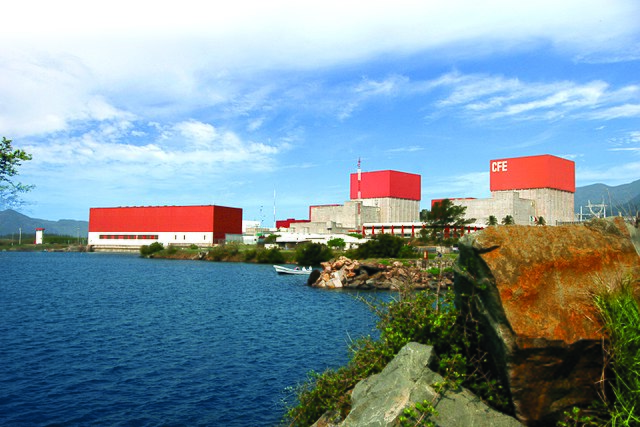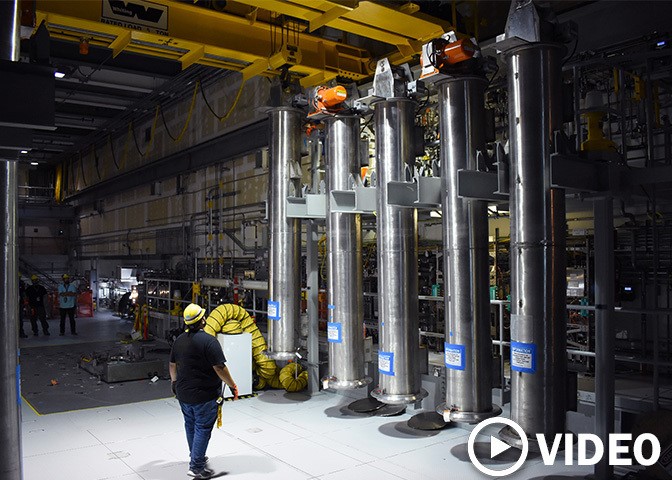The Diablo Canyon nuclear power plant.
Bowing at last to the unflagging efforts of nuclear advocates over the past few years—as well as to more recent pressure from a former nuclear opponent, Gov. Gavin Newsom—the California legislature late last night approved S.B. 846, a measure that provides the option of extending operations at the Diablo Canyon nuclear power plant for five years beyond its scheduled 2025 closure date.
Pacific Gas and Electric, Diablo Canyon’s owner and operator, had agreed in June 2016 to an early shuttering of the facility, following discussions with organized labor and environmental organizations. PG&E’s application to close the plant was approved by the California Public Utilities Commission in January 2018.
The bill passed easily through both legislative chambers: 67–3 in the General Assembly and 31–1 in the Senate.
Tiara Carrasquillo Pérez (far left) and Matt Hageman (far right) are pictured with five other WISE interns and FMR Gil Brown (center front).
For the first time since 2019, student interns were welcomed to Washington, D.C., for the summer to participate in the Washington Internships for Students of Engineering (WISE) program. Among them were two students sponsored by ANS—Tiara Carrasquillo Pérez and Matt Hageman.
The Laguna Verde nuclear power plant. (Photo: HFStudio)
Unit 2 at Mexico’s Laguna Verde nuclear plant has been given the go-ahead to operate into the 2050s, plant owner and operator Comisión Federal de Electricidad (CFE) announced last week.
Mexico’s secretary of energy, Norma Rocío Nahle García, approved a 30-year extension to the unit’s operating license on August 25, following a review by the country’s National Commission for Nuclear Safety and Safeguards. The reactor, one of two at the plant, is now authorized to run until April 10, 2055.
A digital rendering of Egypt’s El Dabaa plant. (Image: Nuclear Power Plants Authority)
Korea Hydro and Nuclear Power (KHNP) has signed a contract with Atomstroyexport JSC—the engineering division of Russia’s Rosatom—to build the turbine islands for Egypt’s El Dabaa nuclear power plant, construction of which commenced just last month with the pouring of first concrete.
A worker watches test bubblers in operation at the Hanford Site. (Photo: DOE)
IAEA director general Rafael Mariano Grossi (center) with his team of nuclear safety, security, and safeguards experts at the Vienna International Airport on August 29, prior to their departure for Ukraine’s Zaporizhzhia nuclear power plant. (Photo: Dean Calma/IAEA)
After months of urgent entreaties to both the Ukrainian and Russian governments to allow the International Atomic Energy Agency access to the embattled Zaporizhzhia nuclear plant, IAEA director general Rafael Mariano Grossi yesterday set off for the facility, accompanied by a team of nuclear security, safety, and safeguards experts.
The NNSA’s Savannah Blalock announces that the agency has reallocated $10 million to support peaceful uses. (Photo: NNSA)
The Department of Energy’s National Nuclear Security Administration has redirected about $10 million from the International Atomic Energy Agency’s low-enriched uranium fuel bank to efforts supporting the peaceful uses of nuclear technology and to fight cancer.
Senate Bill 846 is key to safeguarding grid reliability amid climate change
LA GRANGE PARK, Illinois – The American Nuclear Society (ANS) sent a letter to California state legislators urging quick passage of bipartisan legislation (Senate Bill 846) to extend operations of Diablo Canyon nuclear power plant.
California's Diablo Canyon nuclear power plant.
A bill to extend operations at California’s Diablo Canyon nuclear plant beyond 2025 debuted last evening in the California legislature. Lawmakers have until Wednesday—the end of the current legislative session—to vote on the measure.
Coauthored by State Sen. Bill Dodd (D., Napa) and Assemblymember Jordan Cunningham (R., San Luis Obispo), Senate Bill 846 includes a $1.4 billion forgivable loan to Pacific Gas and Electric (PG&E), the plant’s owner and operator, matching the amount in the August 12 proposal from Calif. Gov. Gavin Newsom. Instead of Newsom’s proposed option for a 10-year life extension for the facility, however, SB 846 would keep the plant running for an additional five years only.
Francesco Venneri (left), USNC CEO, and Hyeon Sung Hong, Hyundai Engineering CEO, at a framework agreement signing for MMR project development and deployment.
Representatives of Ultra Safe Nuclear Corporation (USNC) of Seattle, Wash., and Hyundai Engineering of Seoul, South Korea, traveled last week between USNC project sites in Oak Ridge, Tenn., and Ontario, Canada, to sign two agreements extending their collaboration on the deployment of USNC’s high-temperature, gas-cooled Micro Modular Reactor (MMR). The agreements expand on a business cooperation agreement signed in January 2022 and an engineering agreement signed in June, and follow the closure earlier this month of a previously announced $30 million equity investment after its review by the U.S. Treasury Department’s Committee on Foreign Investment in the United States.
From left: Bas Sujis (ULC-Energy), Sophie Macfarlane-Smith (Rolls-Royce SMR), Joanna Roper CMG (U.K. ambassador to the Netherlands), Alan Woods (Rolls-Royce SMR), and Dirk Rabelink (ULC-Energy). (Photo: Rolls-Royce SMR)
The United Kingdom’s Rolls-Royce SMR has signed an exclusive agreement with ULC-Energy—a Dutch nuclear development company established in 2021—to deploy small modular reactor stations in the Netherlands. (ULC stands for Ultra Low Carbon.)
Artistic rendering of a NuScale nuclear power plant. (Image: NuScale Power)
NuScale Power yesterday announced the signing of a memorandum of understanding with Estonia’s Fermi Energia, a company focused on small modular reactor development to address the Baltic state’s climate and energy security goals.
Under the MOU, Fermi Energia will evaluate the Portland, Ore. – based firm’s small modular reactor design for deployment in Estonia. (There are no nuclear power facilities in Estonia or in the other Baltic countries, Latvia and Lithuania.)
The B Farm underground waste tank area at Hanford. (Photo: DOE)
Washington state’s Department of Ecology and the U.S. Department of Energy have agreed on a plan for how to respond to two underground tanks that are leaking radioactive waste, as well as any future tank leaks, at the Hanford Site near Richland, Wash.
In April 2021, following a year-long leak assessment, the DOE announced that Hanford’s Tank B-109 is leaking waste into the surrounding soil. Tank T-111 was discovered to be leaking in 2013. Currently, Tank B-109 is leaking about 1.5 gallons of waste per day, and Tank T-111 is leaking less than a gallon a day, according to the DOE.
The Zaporizhzhia plant (Image: Energoatom)
Energoatom, Ukraine’s nuclear plant operator, is reporting that Units 5 and 6 at the Zaporizhzhia plant—currently the facility’s only operational reactors—were disconnected from the country’s power grid early in the morning of August 25.
The Zaporizhzhia site has been under the control of the Russian military since March 4, just days after Russia commenced its invasion of Ukraine.





 The National Association of Regulatory Utility Commissioners (NARUC) has published
The National Association of Regulatory Utility Commissioners (NARUC) has published  As energy security and environmental concerns prompt some countries to increase their reliance on nuclear energy or become first-time adopters of the technology, the U.S. government must decide whether it will offer financing for reactor exports—a move that poses financial risks but could create jobs, address global climate and energy security challenges, and limit Chinese and Russian influence. A new
As energy security and environmental concerns prompt some countries to increase their reliance on nuclear energy or become first-time adopters of the technology, the U.S. government must decide whether it will offer financing for reactor exports—a move that poses financial risks but could create jobs, address global climate and energy security challenges, and limit Chinese and Russian influence. A new 


 The deadline for first-round applications to the Department of Energy’s
The deadline for first-round applications to the Department of Energy’s 







